BestReviews is reader-supported and may earn an affiliate commission. Details
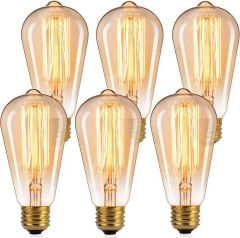
These antique-style lightbulbs have a long lifespan and provide warm amber light.
This set comes with 6 60-watt lightbulbs, each offering 2,500 hours of life. The light is stable, doesn't flicker, and the brightness can be adjusted. They have an amber-colored glass cover and work great on vanity mirrors, light fixtures, and lamp chandeliers.
The light can appear too yellow in some environments.
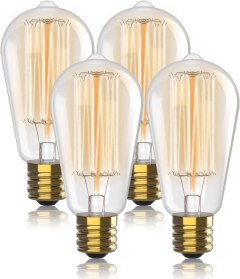
These bulbs stand out not only for their high quality, but also for their excellent packaging and good value.
Users love their beautiful traditional look and white glow, and praise both the appearance and sturdy packaging that keep the bulbs intact during shipping. We like that they give off a good amount of light and look equally attractive whether on or off.
A few reported a slight buzzing when dimming, and a few customers said the bulbs burned out too quickly.
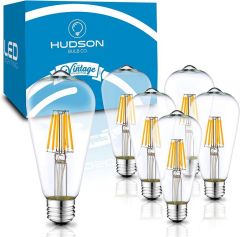
These bulbs have a vintage-inspired design and emit soft, glowing light.
These lightbulbs are dimmable and can be adjusted based on the environment or preference. They offer 60 watts of power output and last 20,000 hours. They don't flicker, are made without mercury, and give off daylight-white light, making them suitable for almost any room.
There are reports of some lightbulbs arriving to customers with minor scratches on the glass.
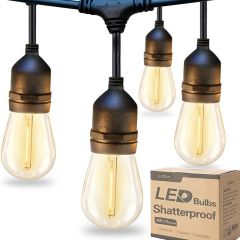
These string lights are excellent for backyards and patios and are made to withstand the elements.
These shatterproof lightbulbs emit a soft glow and are dimmable for brightness flexibility. Up to 30 strands can be linked together, and the weatherproof construction lets them withstand the wear and tear of year-round outdoor use.
There is a lot of space between each bulb.
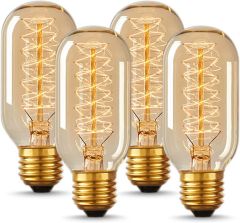
These decorative bulbs have an antique filament and amber glass that let them give off a warm glow.
They come in packs of 4 and have a vintage-inspired appearance. They give off 40 watts of power and have a warm light design, making them suitable for dining halls, libraries, and bedrooms. Each bulb has a 3,000-hour lifespan and is dimmable-compatible.
They're smaller than other Edison lightbulbs.

We recommend these products based on an intensive research process that's designed to cut through the noise and find the top products in this space. Guided by experts, we spend hours looking into the factors that matter, to bring you these selections.

History was made in 1880 when inventor Thomas Alva Edison, building off the work of others before him, submitted a patent for an incandescent light bulb. While Edison wasn’t the first with the innovation, he triumphed commercially, cementing himself as the light bulb’s creator in the annals of history. And the Edison light bulb endures today in a somewhat different form.
Today’s Edison light bulbs are demonstrably different from Edison’s original, but they aim to recreate the original using completely different technology. Indeed, the Edison light bulb is sought after because it’s an attractive bulb that many enjoy for its aesthetics as well as function. Edison light bulbs are varied in terms of appearance and power and are used in many different types of fixtures.
There is plenty of jargon about light bulbs that can make shopping for them confusing. In order to find the best Edison light bulb for you, there are a few important details worth knowing, and we’ve compiled them in this buying guide along with some of our favorites.

The original Edison light bulb was an incandescent light source that converted electricity to visible light by way of a filament of carbonized bamboo. The first Edison light bulb was transparent, so the filament was visible.
Today, consumers buy Edison light bulbs because they want to see the filament, unlike modern LED bulbs with opaque glass. Edison light bulbs offer a retro, vintage, or rustic look, and those who buy these light bulbs are looking for the aesthetic as much as the function. Even the phrase “Edison light bulb” is more a marketing term than anything else because new shapes and styles have been developed since Edison’s original creation.
Edison light bulbs are used in fixtures or sockets that don’t hide the bulbs. Since their appeal lies in their look, the unique nature of Edison light bulbs is wasted when they sit under a shade or cover, which also means they emit light in every direction. Edison light bulbs are most often used in hanging fixtures like pendant lighting in kitchens or bathrooms, often in rooms with farmhouse or rustic décor. Most Edison light bulbs are quite fragile, so it’s important to handle them with care and position them so they won’t be disturbed or bumped.
Edison light bulbs are available as both traditional incandescent bulbs and LED bulbs.
Incandescent bulbs have been around for a long time, and while they’re inexpensive, they aren’t very energy efficient. They also have a shorter lifespan than LED bulbs and tend to take some time to reach peak brightness.
LED bulbs are today’s alternative, and they not only boast a longer lifespan but use less power too. LED bulbs reach their optimal brightness instantly. Edison LED bulbs have an LED strip that acts as the filament in order to recreate the antique look. Most of these are made of tungsten.

Some Edison light bulbs are designed to work with a dimmer. These dimmable bulbs are often used in bedrooms or other rooms where you want to control the ambiance. Bulbs that are incompatible with dimmer switches can flicker or hum.
Recent innovations incorporate light bulbs into the modern smart home. Some companies sell bulbs that are intended to be used with smart outlets and hubs. Depending on the platform, you can control your home’s smart lighting by voice or app. Generally, the light bulbs aren’t particularly expensive, but the first hub you purchase to operate the system can be costly.
The color temperature of a bulb can dictate the mood and ambiance of a room. Color temperature is measured in kelvins on a scale of 1,000 kelvins (candles) to 10,000 kelvins (blue light).
Cool: On the one end of the spectrum, bluish-white and cool white are bright and cool, ideal for spaces like kitchens and bathrooms.
Warm: At the other end of the spectrum are warm temperatures that mimic the glow of candlelight. This describes the earliest incandescent light bulbs. Warm light is often used in living rooms and dining rooms for a calmer, more relaxed, even romantic ambiance.
Modern Edison light bulbs come in a variety of stylish shapes designed to cater to various styles of home décor.
Bulb: In addition to the standard light bulb shape, you’ll find a few other options including the hairpin or tubular bulb. Globes are also popular. Some options have a dimple on the end while others have a more pronounced tip.
Filament: The filaments can differ too. Some are straight while others are spirals, helixes, or cages. Other bulbs have multiple filaments. Among the more popular options is the candelabra bulb that’s designed to mimic flame.

Smart light switch: WeMo WiFi-Enabled Light Switch
For those looking for added convenience and accessibility in their smart home, it’s time to upgrade to a smart lighting system. We recommend this simple push-button option by WeMo that works with virtual assistants like Alexa.
Bathroom light fixture: Design House 3-Light Fixture
Edison light bulbs are popular in modern bathrooms but require the right fixture. We like this rustic option from Design House that shows off the Edison bulbs to perfection.
Inexpensive: For $8 or less, you can buy a pack of two or three Edison light bulbs with a standard bulb and filament shape.
Mid-range: Most packs of Edison light bulbs cost between $8 and $20 depending on the number and type. These include LED bulbs.
Expensive: LED Edison light bulbs featuring unique designs and styles start at about $10 a piece.


A. You can expect a quality LED light bulb to last many years, even up to a decade depending on use. Incandescent light bulbs have a much shorter lifespan. Most products express the lifespan as a number of hours. Incandescent bulbs range from 1,000 to 5,000 hours, while LEDs may last anywhere from 10,000 to 50,000 hours. As a guide, there are just under 9,000 hours in a year. Figure out how much of the time your bulb is on and you can figure out its lifespan.
A. Wattage tells you the power of a light bulb. The light output (brightness) is measured in lumens. Wattage doesn’t directly correspond to lumens because of the varied efficiency of different types of light bulbs. LED bulbs are far more efficient. While a standard 60-watt incandescent bulb has 280 lumens, a standard 9-watt LED bulb has 800 lumens.
A. The first step to figuring this out is to measure the space and calculate the square footage by multiplying the length by the width. Generally, in kitchens and bathrooms, you want about 70 to 80 lumens per square foot, while living rooms and dining rooms tend to be around 30 lumens per square foot. For hallways and bedrooms, 10 lumens per square foot may suffice.
Get emails you’ll love.
Learn about the products you’re wondering if you should buy and get advice on using your latest purchases.
